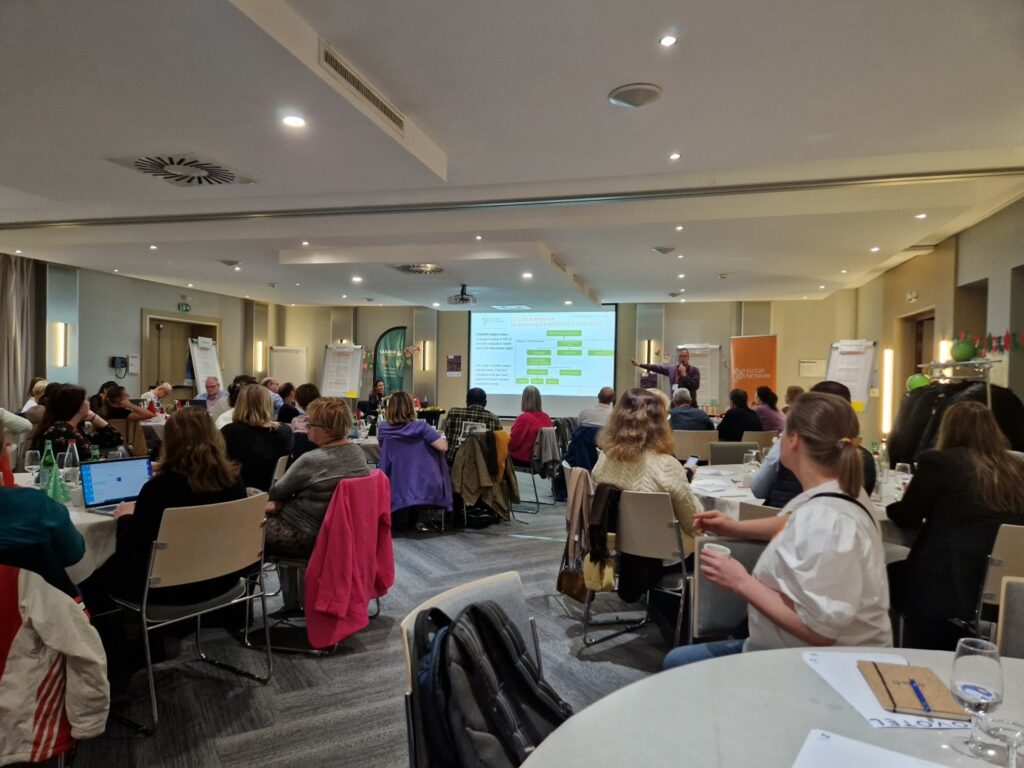 On 23 and 24 November 2023, some 60 evaluators, representatives from managing and paying authorities, LEADER networks and LAG managers met at the Kirchberg in Luxembourg city, at the invitation of the European Evaluation Helpdesk for the CAP and the Ministry of Agriculture, Viticulture and Rural Development of Luxembourg. The central topic of this Good Practice Workshop was the question of “How to Assess the LEADER Added Value”.
On 23 and 24 November 2023, some 60 evaluators, representatives from managing and paying authorities, LEADER networks and LAG managers met at the Kirchberg in Luxembourg city, at the invitation of the European Evaluation Helpdesk for the CAP and the Ministry of Agriculture, Viticulture and Rural Development of Luxembourg. The central topic of this Good Practice Workshop was the question of “How to Assess the LEADER Added Value”.
The first day saw a series of presentations of what has been perceived as good practice in assessing LEADER: Robert Lukesch presented a study on social innovation in LEADER 2014-2020 in Austria. Sari Rannanpää presented the Finnish approach to evaluating the LEADER principles and quality of governance. Further presentations came from Carl Strömberg (Sweden) and Neringa Virsilene (Lithuania), the latter explaining a quite elaborate approach which amounted in what they call PILA (Performance Index of the LEADER approach). Finally Ecorys presented its recent study on the “Cost and benefits of the implementation of LEADER” which the Evaluation Helpdesk carried out in direct response to the critical assessment of the European Court of Auditors which in its recent Special Report (2022) gave consideration to the lack of empirical evidence that the relatively higher implementation cost of the LEADER measure actually got outweighed by the higher benefits it is supposed to create in terms of social capital, better local governance and enhanced results at project level (see a review HERE). All in all, this added value could be identified in the study. We quote from the “key findings”:
- “Results suggest that higher costs are justified to ensure wide participation of the local population in LEADER governance systems, but more can be done to ensure participation of young people and women….
- Thanks to the activities undertaken by the LAG and its network, the level of trust towards the LAG increases. LAGs are able to activate social capital and establish networks inside and outside the LAG area beyond project support. Time used for networking by LAG members contributes to improved mutual learning, which is the necessary pre-condition for local development to take place and to improve over time.
- The more effective the LAG is in promoting collaboration among local actors to reinforce local production and local assets, the better the project performance and the results (will be) compared to non-LEADER projects. Such benefits justify higher costs: Time dedicated by LAGs to decision-making, presence of specific professional figures in the LAG dedicated to animation, cooperation coordination, M&E; share of running and animation costs on the total budget of the LAG.
- Animation, networking and technical assistance provided by LAGs are effective in supporting potential beneficiaries to obtain LEADER financing, improving the quality of supported projects and the performance of local enterprises.
- Despite small scale/limited financial resources, LEADER projects are more effective in terms of public expenditure per job created compared to similar projects at RDP level – achieved thanks to animation, technical assistance and networking by LAGs.”
On the second day of the Good Practice Workshop, challenges and solution paths for the current period have been discussed. Christa Rockenbauer-Peirl from the Austrian Managing Authority presented the Austrian approach to evaluate the added value of LEADER on the basis of an impact model which operationalises more in detail the framework established in the LEADER evaluation guide of the Helpdesk from 2017. Much attention was also given to the presentation of Elena Pisani from the TESAF Institute of the University of Padova, Italiy, who showed examples of assessing the characteristics of social capital at LAG level along the three dimensions: governance quality, normative-cognitive and structural social capital using the social network analysis. Furthermore she proposed an indicator named Network Diversity Index (NTd) which is calculated in the same way as the Gini-Index: by the NTd the changes in the representation of individual actors belonging to different categories (public, private, associative…) in the LAG board and among LAG members over time can be measured. Elena said that all these indicators should not be used to compare different LAGs with each other, as this would not do justice to the different contexts and circumstances in which LAGs operate. However they could be helpful to monitor the evolution of one and the same LAG over time.
The Helpdesk is currently preparing an update of the abovementioned LEADER evaluation Guidelines, and most probably the indicators proposed by Elena Pisani will figure in these updated Guidelines.
The Good Practice Workshop ended with a field visit to the LEADER Region Zentrum Westen, which borders the capital of Luxembourg towards the north-west. The local actors presented two projects:
- The ‘Histoschool’ LEADER-project which valorised the local history of the region for primary school children. A wealth of information material has been created in the project, guiding children through different historical eras.
- The ‘Guttland.Trails’ LEADER-project which created a new tourism offer in the region based on short circular trails.
Robert Lukesch
8.12.2023
Leave a Reply
You must be logged in to post a comment.